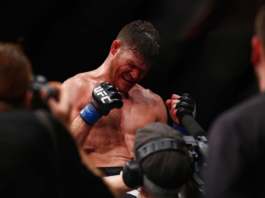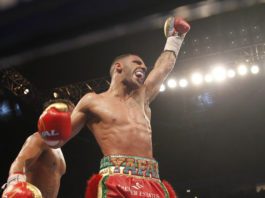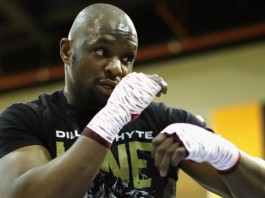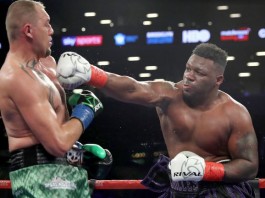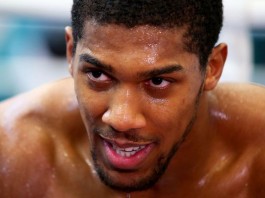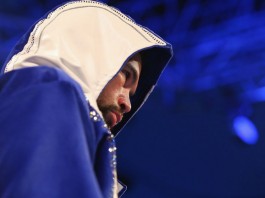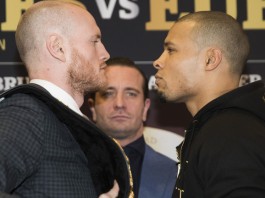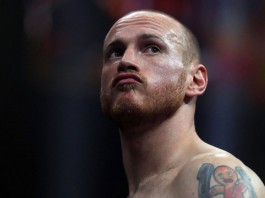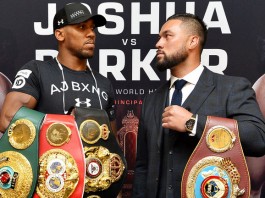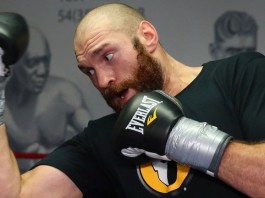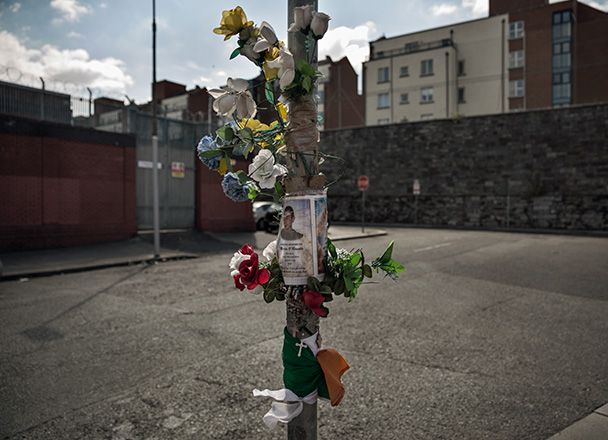
This story appears in ESPN The Magazine’s August 11 Fighting Issue. Subscribe today!
Just before Christmas, the drug dealers hanging on a north Dublin corner saw Conor McGregor’s white BMW turn down their dead-end road.
They couldn’t believe it. Sheriff Street was among the worst streets in the city, blocked off at one end, the area controlled by one of the two local gangs. The Hutch family ran this part of the north side, while the Kinahans operated mainly in the neighborhoods south of the river dividing the town. Some of the Kinahan bosses and foot soldiers lived in Crumlin, where McGregor grew up. The two gangs were in a bloody feud that had Dublin on edge and the newspapers keeping score: 10 killed by the Kinahans, two killed by the Hutches. McGregor started to slow down. The dealers stepped out into the street, blocking his escape.
A woman is telling me this story, standing in the corner store on a street that a local crime writer calls the Hutch family’s “Alamo.”
“He’s from the south side,” she explains. “He’s not from this side.”
Down the road, there’s a festival going on. An organizer there unloads crates of bottled water and, when asked, gives more details about what happened next. “I’m telling him about the night McGregor drove into Sheriff Street by accident,” he says when a woman joins him.
“Yeah,” she says.
“… and he couldn’t wait to get out,” he says.
“He took a wrong turn …,” she says.
“… in a white Beamer,” he says.
“And all the kids was running,” she says.
“All the gang was standing outside the chipper selling gear,” he says. “When he drove past the chipper, all the youngsters said, ‘Hey, McGregor!’ And when he got to the end of Sheriff Street, he realized there was no way out and he done a U-turn. And when he was doing a U-turn, three or four of ’em got out in the middle of the road. The feud was up and running, and he’s kinda loosely connected with a few of the Kinahan cartel.”
McGregor hit the throttle and roared down the street. Drug dealers scrambled to whatever safety they could find as he sped through the intersection. A wise move in practice, but McGregor had underestimated the mania sweeping the projects and the lower-class quarters of Dublin. The dealers didn’t want to confront him.
They all had a phone in their hands.
They wanted to take his picture.
Sheriff Street is one of the worst streets in Dublin. Finbarr O’Reilly for ESPN
He’s a working-class hero in a working-class city. However he’s viewed around the world — a race-baiting trash-talker, say, telling Floyd Mayweather to “dance … boy” — he is beloved in neighborhoods like Crumlin, around the Dock Ward where the famine coffin ships left for America, on Sheriff Street and in the boxing clubs that anchor the many insular neighborhoods. Sitting in a locker room as he prepares for his Aug. 26 fight against Mayweather, McGregor talks in a humble voice about Dublin’s support.
“That’s my people,” he says with a quiet ferocity. “That’s who I am.”
Most Irish sporting champions reflect the lilting reserve of the green hills. That’s not Conor. He’s inner-city Dublin personified. He carries the lingering spirit of the tenements off O’Connell Street, the projects of Oliver Bond and the cruelly named Fatima Mansions, where his old boxing coach Phil Sutcliffe lost a brother in a drug deal gone bad. Any mysteries about him can be solved on his home turf: an area named Crumlin, built in the 1930s just south of Dublin’s center, when the government tore down the inner-city tenements and needed a new place to house the poor. The Irish revolutionary writer Brendan Behan was one of those moved there, and he described his new home as a place “where they eat their young.”
Dublin is best understood by exploring its many divisions, its unending physical and mental boundaries. The city, and its current champion, McGregor, are defined by those limits. It’s a clannish, parochial place. Crossing the wrong street has traditionally been reason enough for an ass-whipping. Men have had to drop dates off at bus stops instead of walking them all the way home. About 60 boxing clubs still dot the city, training kids to defend themselves and their block, each gym a world unto itself. Sutcliffe, who runs the historic Crumlin Boxing Club, where Conor got his start, remembers growing up in the next project over, in Drimnagh. The neighboring, rival communities of Crumlin and Drimnagh are within the gritty Dublin 12 postcode, separated only by Crumlin Road, which runs on an east-west diagonal. Sutcliffe, who boxed in the 1980 and ’84 Olympics, wanted to train in the Crumlin gym, which had better coaches. He beat up men who tried to stop him from crossing Crumlin Road.
“Not on me own,” he says modestly. “With my brothers.”
Other divisions in the city revolve around class, and while Conor’s success allows him safe passage across gangland boundaries, it can’t overcome his Dublin 12 roots. The Irish national daily papers have long served as the mouthpiece of the upwardly mobile and educated. McGregor rarely makes their pages. On the first morning of the prefight media tour, The Irish Times and the Independent ran a combined 128 words about it: one small story about Mayweather’s tax problems. Then after McGregor dropped his racist taunts during the tour, the two papers filled pages with essays and think pieces, and one story compared him to Donald Trump, calling him a disgrace to Ireland, its people and its flag. They’d been lying in the shadows, waiting for him to violate some code of modern life, and while they seem legitimately outraged at his racist comments, it’s clear they’re outraged at the idea of him too.
McGregor loves tweaking Dublin’s two-tiered society; this spring, he bought a boat and parked it in a snooty marina in a snooty coastal town, near where U2’s Bono and The Edge live. He named it The 188, which is the amount of the weekly welfare payments he got until he started making money in the cage. Proper Dublin recoils from his type: the Crumlin hood rat, shaped by the limits that define him, hem him in, make him feel caged.
McGregor’s old neighborhood, and all of Dublin 12, lives by old codes. “It can be dangerous if you cross the wrong people,” says Jamie Kavanagh, a professional boxer who grew up with Conor. Jamie’s father, Gerard, was a mob enforcer and was killed three years ago, gunned down in Spain. The tabloids called him The Hatchet. Another Kavanagh relative, Paul, was murdered a year later. Now Jamie lives in London and is taking his family to America to train. “When you’re growing up from that neighborhood, everybody has each other’s back,” he says. “When you step out of that neighborhood, you’re gonna run into problems. I would never live in Dublin again. I wouldn’t want my kids growing up in the same neighborhoods.”
Phil Sutcliffe runs the historic Crumlin Boxing Club, where Conor got his start. Finbarr O’Reilly for ESPN
McGregor sits in a locker room at the end of a recent sparring session, talking about how he navigated the boundaries of his hometown. He and Gerry Byrne, a friend since childhood, tell stories about growing up in Crumlin — where the two most prominent Dublin gangland feuds in the past 20 years started. The friends lived through them. Gerry says he escaped a drive-by shooting, a guy with a sawed-off shotgun on the back of a moped. Conor got in a fight with the younger brother of a well-known mobster.
“I love Crumlin,” McGregor says. “It makes you a strong person.”
Everyone in Dublin followed the Crumlin-Drimnagh feud, which started in 2000, but McGregor actually knew the people doing the killing and the people being killed. He turned 12 when it began, and his transition from a boy to a man happened in this place colored by violence and revenge. In all, 16 people died, and many more went to prison, and nearly every combatant trained at the Crumlin Boxing Club alongside McGregor.
“Those guys in that feud, they all crossed them doors,” says Kavanagh, the boxer. (“All them guys been in that boxing gym. All of ’em.”
The tabloids read like a Dennis Lehane novel, day after day, a man shot in his bed, another stabbed in the heart with a kitchen knife, another smuggling in a rocket launcher into Dublin. Perhaps no character caught the city’s attention like a gangster named Micky Frazer. He reportedly drove “Fat” Freddie Thompson, one of the two main actors in the feud, and somewhere along the line Frazer ran afoul of someone in Fat Freddie’s camp. To date, Frazer has survived at least five attempts on his life. He got shot in a church parking lot. A grenade was thrown into his mother’s house. A gunman shot holes in the front windows. The Sunday World tabloid reported that at one point Frazer danced on a pub table and bellowed, “I’m invincible!”
McGregor and his friends watched Frazer, and many more people like him, marked for death. The glut of hit men willing to kill for cheap left an impression, as did the unending list of victims. “They were ‘the man’ last week,” McGregor says, “and now they can’t even leave their home. As a group of friends, we all saw this.”
Sitting in a chair across from Gerry, Conor gets a little nervous talking so much about gangland Dublin. His MMA gym is just outside the old neighborhood, and even though his family moved to the suburbs when he was about 17, he finds himself called back to these familiar streets. “I still am in Crumlin every day,” he says. “There’s still s—. Now there’s cartels.”
He’s talking about the Kinahan-Hutch feud, which broke into the open a year ago at the weigh-in before one of Kavanagh’s fights. Six Hutch gunmen, some of them with automatic rifles, burst into a ballroom crowded with fans and children and executed a Kinahan boss, which set off an orgy of revenge killings that hasn’t stopped. In the days after the shooting, a photo emerged of the dead mob boss and McGregor together. They grew up training in the gym in Crumlin, and the boss and his crew allegedly flew to Las Vegas to see Conor fight Jose Aldo. McGregor had his picture taken at the funeral of an alleged Kinahan gang member. His sister married a former weed dealer who did three years in prison.
That world was always there for Conor, yet he never became the most charismatic and terrifying debt collector in the streets of Dublin. He and his friends knew they didn’t want the paranoia or prison stints or early death that surely follows the selling of cocaine. That line took courage to hold, but McGregor held it, never dealing, according to a senior police officer who investigates organized crime and requested anonymity. The criminals agree, according to a former dealer named Johno Frazer, “the invincible” Micky’s younger brother. He says Conor never dealt. He should know.
He and Conor once got into a fight over a girl.
Johno won.
Whatever the neighborhood, Conor McGregor’s charisma transcends Dublin’s tribalism. Finbarr O’Reilly fro ESPN
About a week before McGregor moved his training camp from Dublin to Las Vegas this summer, over in a Drimnagh cul-de-sac, Johno Frazer stood in front of his house, which he inherited from his recently deceased mother. This was the same place once attacked with a grenade. A crease marked the door, and the splintered glass of a bullet hole remained in the window above it. Johno wore scars on both sides of his neck, a permanent reminder of a prison murder attempt. He stepped out into the street and described his fight with McGregor. “I gave Conor a few slaps,” he says. “I was in a gang. Conor wasn’t in a gang. He went walking up the Crumlin Road with a girl I was with, and I hit him.”
Frazer admires how McGregor never joined with them or dealt drugs, choosing instead the safe, low-paying job of a plumber. Later, he says, they became friends, boys who hung just up the road in what passes for a downtown of Crumlin and Drimnagh: a chip shop and a pub, a butcher and a convenience store. He says they even went on vacation to Greece with a group of friends. “We were all drug dealers, and we all had loads of money,” Frazer says, laughing. “Conor had none. Conor stayed in our room on a blow-up bed. His dad was ringing him, ‘He has to come home, go back to plumbing.’ He didn’t want to go back.”
He opened the door and gestured inside.
“Feel the windows,” he says. “The windows are bulletproof. Tap on them.”
The kids from the old neighborhood respect the new life McGregor has built. They remember when he came round the cul-de-sac in his girlfriend’s beat-up Peugeot 206. The night of his last fight before the UFC, he forgot his cup or his mouthpiece and didn’t have enough credits on his phone to call someone to bring them. Now he’s worth millions and still comes around. “He never forgot the roots,” Johno says. “He didn’t forget where he came from.”
There was a time, Johno says, when he and Conor walked these streets, without plans beyond the moment, and now they occupy different worlds. Johno landed some shots on a now-famous man when they were boys, but his own personal ethic prevents him from flexing, or crowing, or showing anything that might not be a sign of respect for the distance Conor has traveled, even if Johno remains in the house where the mob tried to kill his brother, wearing the lifelong scars of the Crumlin-Drimnagh feud.
“I wouldn’t try fighting him now,” Johno says. “That’s a fact. And Conor wasn’t afraid of me. He was afraid of what I’d be able to do. He was afraid I’d stab him. That’s a long time ago.”

